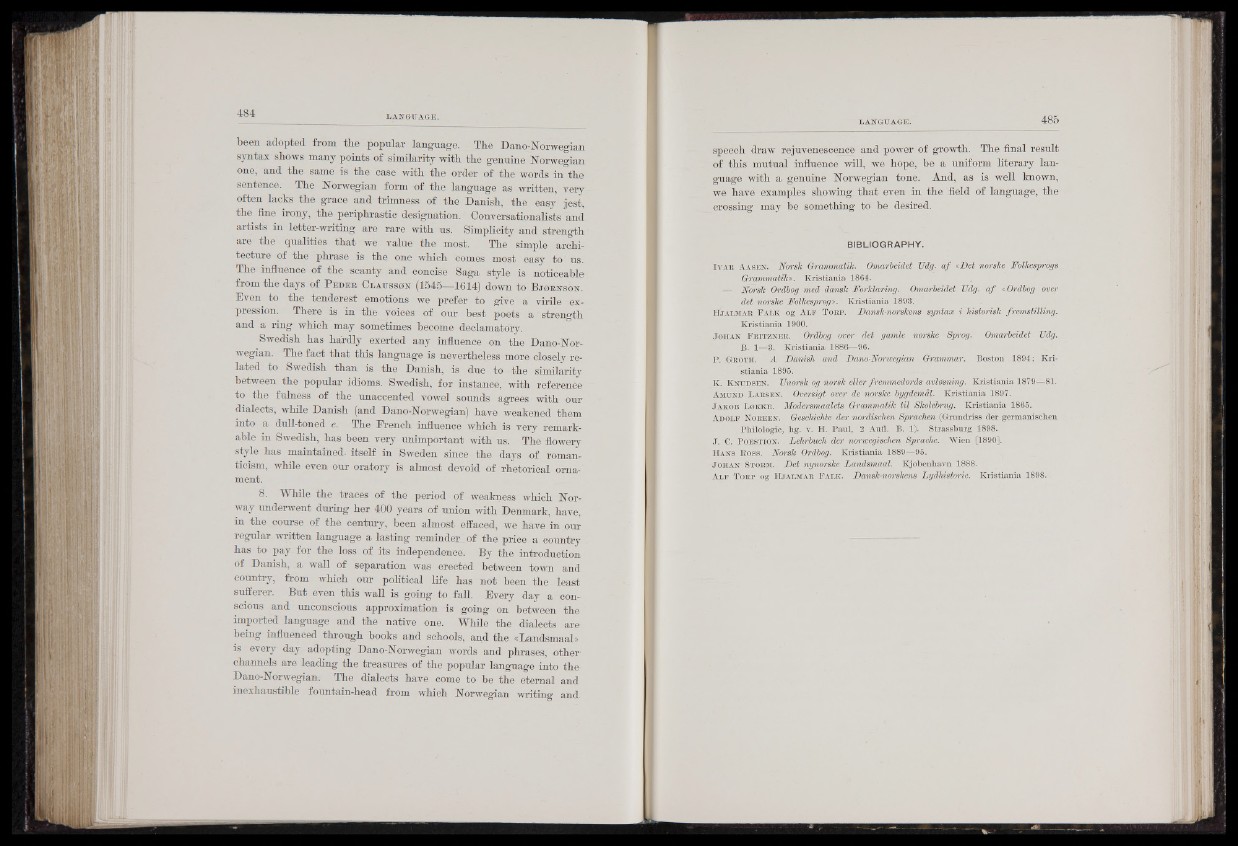
been adopted from the popular language. The Dano-Norwegian
syntax shows many points of similarity with the genuine Norwegian
one, and the same is the case with the order of the words in the
sentence. The Norwegian form of the language as written, very
often lacks the grace and trimness of the Danish, the easy jest,
the fine irony, the periphrastic designation. Conversationalists and
artists in letter-writing are rare with us. Simplicity and strength
are the qualities that we value the most. The simple architecture
of the phrase is the one which comes most easy to us
The influence of the scanty and concise Saga style is noticeable
from the days of P e d e b C l a u s s o n (1545—1614) down to B j o r n s o n .
Even to the tenderest emotions we prefer to give a virile expression.
There is in the voices of our best poets a strength
and a ring which may sometimes become declamatory.
Swedish has hardly exerted any influence on the Dano-Nor-
wegian. The fact that this language is nevertheless more closely related
to Swedish than is the Danish, is due to the similarity
between the popular idioms. Swedish, for instance, with reference
to the fulness of the unaccented vowel sounds agrees with our
dialects, while Danish (and Dano-Norwegian) have weakened them
into a dull-tohed e. The Erench influence which is very remarkable
in Swedish, has been very unimportant with us. The flowery
style has maintained, itself in Sweden since the days of romanticism,
while even our oratory is almost devoid of rhetorical ornament.
8. While the traces of the period of weakness which Norway
underwent during her 400 years of union with Denmark, have,
in the course of the century, been almost effaced, we have in our
regular written language a lasting reminder 1 of the price a country
has to pay for the loss of its independence. By the introduction
of Danish, a wall of separation was erected between town and
country, from which our political life has not been the least
sufferer. But even this wall is going to fall. Every day a conscious
and unconscious approximation is going on between the
imported language and the native one. While the dialects are
being influenced through books and schools, and the «Landsmaal»
is every day adopting Dano-Norwegian words and phrases, other
channels are leading the treasures of the popular language into the
Dano-Norwegian. The dialects have come to be the eternal and
inexhaustible fountain-head from which Norwegian writing and.
speech draw rejuvenescence and power of growth. The final result
of this mutual influence will, we hope, be a uniform literary language
with a genuine Norwegian tone. And, as is well known,
we have examples showing that even in, the field of language, the
crossing may be something to~ be desired.
BIBLIOGRAPHY.
I v a e A a s e n . Norsk Grammatik. Omarbeidet Udg. a f n-Det norske Folkesprogs
Grammatik». K r is tia n ia 1864.
•, Norsk Ordbog med dansk Forklaring. Omarbeidet Udg. a f <i Ordbog over
det norske Folkesprogs. K r is tia n ia 1893.
tt.ta t.m a t?. F a l k og Al f T o e p . Dansk-norskens syntax i historisk fremstilling.
K r is tia n ia 1900.
J o h a n F b it z n e b . Ordbog over det gamle norske Sprog. Omarbeidet Udg.
B .Ä - 3 . K r is tia n ia 1886—96.
P . Gb o t h . A Da/nish and Dano-Norwegian Grammar. B o s to n 1894; K r is
tia n ia 1895.
K. K n tjd s e n . Unorsk og norsk eller fremmedords avl0sning. K r is tia n ia 1879—81.
A m u n d L a e s e n . Oversigt over de norske bygdemäl. K r is tia n ia 1897.
J a k o b L o k k e . Modersmaalets Grammatik til Skolebrug. K r is tia n ia 1865.
A d o l f N o b e e n . Geschichte der nordischen Sprachen (G rn n d ris s d e r g e rm an is ch en
P h ilo lo g ie , h g . y. H . P a u l^ ,2 Aufl. B. 1), S tra s s h n rg 1898.
J . C. P o e st io k . Lehrbuch der norwegischen Sprache. Wien [1890].
H a n ts R o s s . Norsk Ordbog. K r is tia n ia 1889—95.
J ohaet St o bm . Det nynorske Landsmaal. K jo h e n h a v n 1888.
Al f T o b p og H ja lm a b F a l k . Dansk-norskens Lydhistorie. K r is tia n ia 1898.